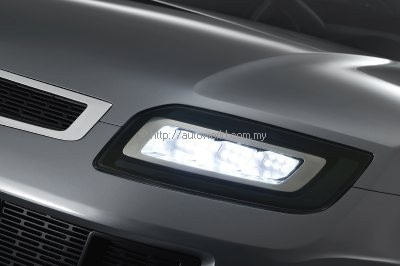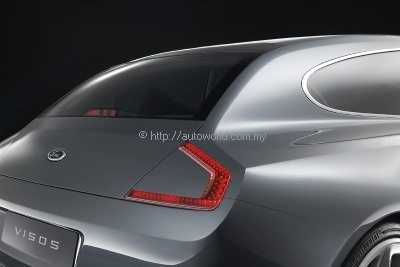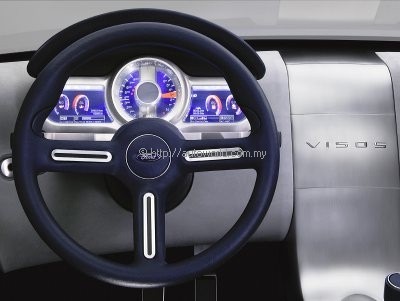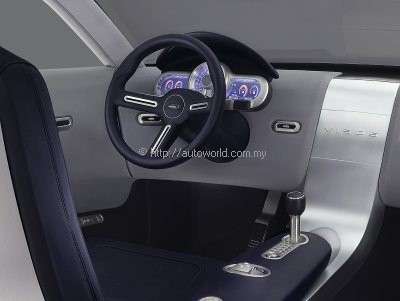Visos Shows Ford’s Future Design Direction
Most manufacturers go through an evolution in their design philosophy, the older ones having a long history to draw upon for inspiration and ‘guidance’. As a 100-year old company, Ford certainly has much to look back upon, design-wise and as it moves into its second century, it is taking yet another path down the ‘evolutionary design tree’ for its products.
Clues to the direction it will take from now on can be found in the Visos design study which was unveiled in Frankfurt recently. More than just a showcase for new ideas in automotive electronics, use of space, and interaction between man and machine, the Visos is a 3-D presentation by the new and enthusiastic designers at Ford.
The Visos is not a specific future Ford model but many of its ideas will be tested and incorporated in future models. Conceptually, it is a fusion of a true sportscar and a luxury touring car which can convey four adults in comfort and also at a brisk pace.
It is packed with the sort of innovation and new technologies that consumers of today and coming years expect. The inside bristles with LCD panels and futuristic controls, while the outside remains sleek, thanks to ‘Active Surfacing’ – a technique that sees the technologies of the vehicle hidden, until they are called for by the driver, the road condition or the vehicle’s dynamics.
“To me, the Visos is all about innovation. As the name suggests, Visos is a strong hint at the shape of things to come, said Chris Svensson who led the concept model’s design team. “It gives a glimpse not only of what Ford of Europe’s future vehicles may look like, but also of the challenges that designers will face in the future. Our team not only addressed each of Visos’ challenges, but also often turned them into advantages that allowed us to entertain, to be dramatic and truly to push at the limits of car design.”
Interior packaging in the Visos takes an entirely new approach which has enabled four adults to fit into a shape that is as sleek as a Focus. This was achieved by giving it dramatic, wide shoulders, enabling equipment that would normally be found behind the instrument panel, for example, to be moved into the car’s flanks. This in turn allowed the designers to dramatically decrease the size of the instrument panel, freeing up valuable cabin space.
“We decided to use doors that open in a conventional way, but extended them to cut deep into the roofline. The roof itself lifts up and folds inward on either side, for easy access to the rear seats,” added Mr Svensson. “Despite interior space that is appropriate to a luxury touring car, we managed to retain the energetic lines of a sports coupé. We also hid the B-pillar behind the side-window glass, and created a sharply curved C-pillar to give a distinctively Ford look to the side view.”
From the outset of the project, the idea was to create a vehicle that incorporated clean, elegant lines and dramatic proportions that conveyed its purpose and character. Using ‘Active Surfacing’, it was possible to hide the aerodynamic aids normally associated with high performance cars and only call on them when required. This retains the purity of Visos’ purposeful exterior shape without compromising its performance potential.
When the driver selects Sport mode, a series of changes occur on the exterior, the interior and to the performance characteristics of the car. Externally, this results in the deployment of the front splitter, the rear diffuser and the rear spoiler. In Comfort mode, the vehicle does not necessarily require the same aerodynamic assistance and so these devices are retracted into the body. Regardless of the operating mode, the aerodynamic aids are deployed automatically at 90 km/h.
‘Active Surfacing’ is also evident in integrated door cameras that fold flush into the door panels when the vehicle has been ‘shut down’. When the engine is started the cameras automatically rotate out of the door surfaces. The camera imaging system provides a clear rear view and it features ‘blind spot detection’ to warn the driver if it is not safe when changing lanes. When the car is parked the cameras retract into the car’s bodywork, ensuring that they are fully protected from dirt or damage.
The front lights use a combination of different technologies to create a distinctive light graphic that is a key design signature for the face of the car. It was very important to the team that the car have a strong presence on the road, even at night, and that it was clearly identifiable.
‘Tinkering’ with their car on weekends is something that enthusiasts no longer get to enjoy, what with the electronics and everything pre-programmed into the car today. Ford designers understand this and with the Visos, the enthusiast is welcome back under the bonnet.
An LCD monitor, mounted to one side of the engine, displays the current set-up. By plugging a laptop computer into a USB port, next to the LCD monitor, the user can change settings that control such attributes as the dampers, rpm-limiter and much more. Users can even download preset configurations from a dedicated Ford server on the Internet, or swap setting files with other owners.
Power for the Visos comes from a 6-cylinder bi-turbo engine rated at 257 kW/350 ps and 400 Nm. The engine is mated to a 6-speed advanced ASM transmission, driving all four 20-inch wheels.
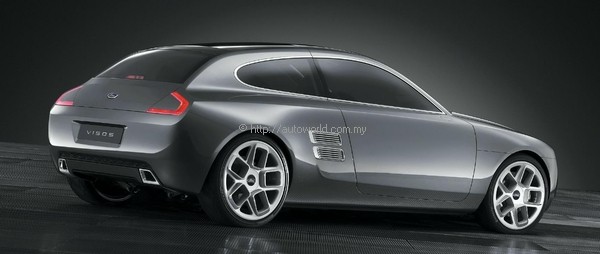 |




